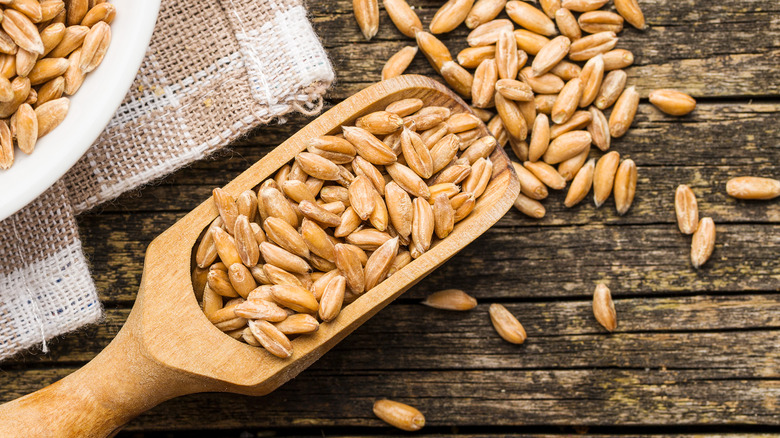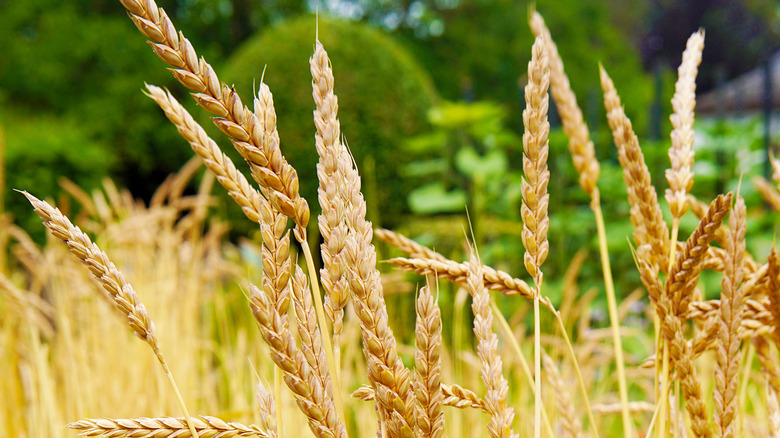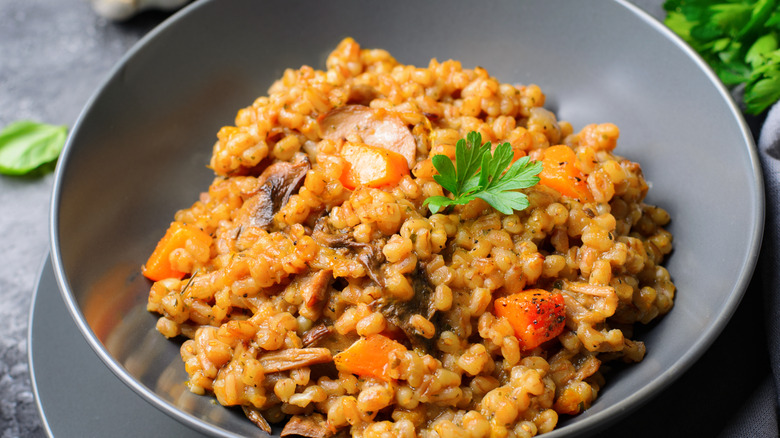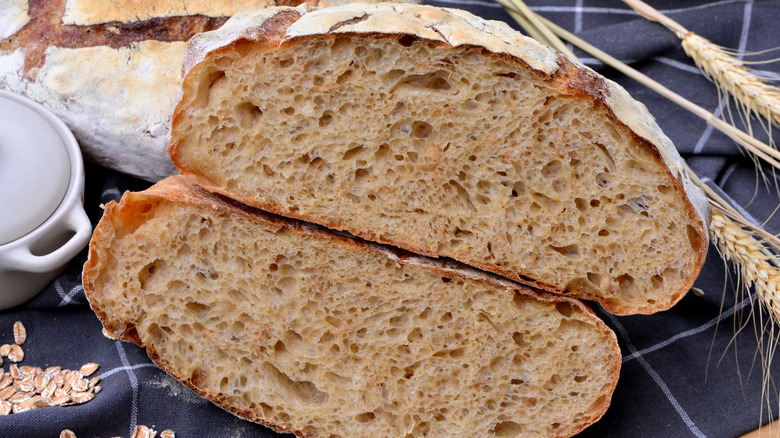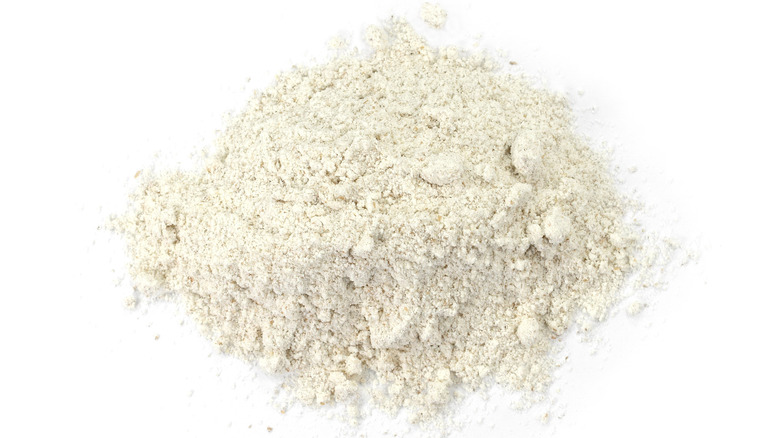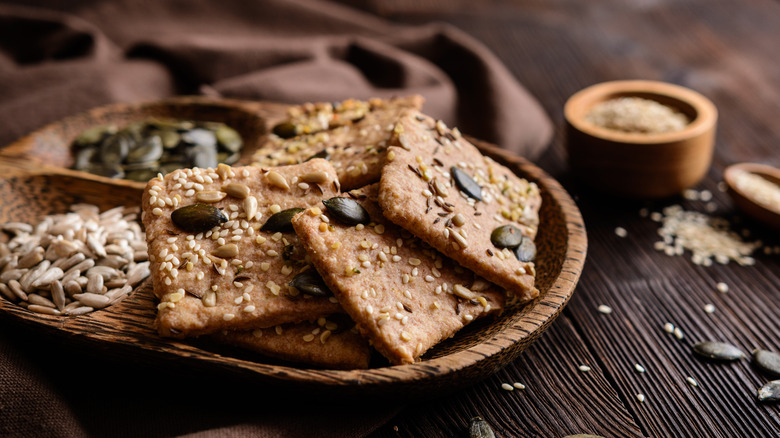The Truth About Spelt
Today's growing army of health nuts, eco-warriors, and clean eaters often strive to return to simpler times, reinvigorating key ingredients that were once considered staples, and ancient grains are no exception. Though the Oldways Whole Grains Council admits there's no true definition for the catchall term "ancient grains," the organization defines them as those that have remained "largely unchanged over the last several hundred years" — meaning that modern wheat definitely doesn't fit the description.
And, to augment their back-to-nature billing, the council reports that ancient grains often require less environment-damaging processes (think fertilizers, pesticides, and irrigation), making them a no-brainer for sustainable sensibilities. One such grain enjoying a resurgence as a modern-wheat alternative is spelt.
The long history and nutritional benefits of spelt
According to Organic Facts, spelt (Triticum spelta), with a history stretching back thousands of years, is one of the world's oldest cultivated crops. As a subspecies of wheat, it closely resembles wheat but features a heartier husk and additional nutritional perks (via Medical News Today). Though spelt, like any wheat, is decidedly carb-heavy, Medical News Today explains that it offers more protein than wheat, while providing solid levels of dietary fiber, iron, magnesium, phosphorus, zinc, and niacin. However, also similar to any wheat, Organic Facts warns that spelt can spell trouble for those with celiac disease or gluten intolerance.
What is spelt used for?
Healthline notes that spelt can be incorporated into one's diet via the whole-grain version (washed and soaked overnight) or flour made from spelt, which can replace traditional wheat flour in many recipes by halving the amount. For example, the Oldways Whole Grains Council advocates spelt flour for making breakfast favorites like waffles and pancakes, while the whole grains can add tender chew to savory sides and mains like risotto (think of them as a rice or farro alternative).
Lately, you may even find yourself guzzling down byproducts of these ancient grains — Feast magazine reported in 2019 that craft brewers are increasingly tapping its "mild, nutty flavors" for a variety of beer styles. Okay, maybe its myriad health benefits don't translate in beer form, but we can still all raise a toast to spelt's impressive versatility.
The history of spelt
The Spruce Eats calls spelt an "heirloom grain" that was "revitalized" in the early 2000s when organic farming helped to bring spelt back into the mainstream grain lexicon. Kitchn notes that the natural shape of spelt is almost orzo-like, and that its flavor is inherently nutty. BBC Good Food states that the Romans apparently called it "the marching grain" because it often helps to boost the energy of anyone who consumed it.
Spelt flour can have a toasty, deeper note, which helps set it apart from the relatively neutral-tasting all-purpose flour. Spelt is very similar to other "ancient grains" like einkorn and korhaan, according to The Spruce Eats. A loaf of spelt bread often boats a crispy outside and a dense, chewy interior. It also makes great toast.
While some specialty stores stock spelt or spelt flour, it may be easiest to source it from a reputable online vendor, in case you don't live in an area rife with specialty grocery stores. There is currently a growing awareness and celebration of ancient grains, though, so you may be able to find it more easily than you think.
What is the difference between AP and spelt flours?
It's also important to distinguish between spelt flour and whole spelt. Bon Appétit speaks about spelt flour, which is an all-purpose, whole wheat flour that is made from the entire grain. According to Bon Appétit, Roxana Jullapat calls spelt a "gateway grain" because it's easier to find than some other wheat flours, which has helped many incorporate it into their home pantries with ease. Spelt flour can lend a slightly acidic or tart flavor. While there isn't an enormous difference between AP and spelt flours from a nutritional perspective, it is thought that spelt flour ever so slightly "outranks" the nutritional benefits of standard AP flour. Bon Appétit also states that while most AP flours are shelf-stable, it is advisable to refrigerate spelt flour, due to the difference in the preparation of the flour and its propensity to turn rancid, dependent on temperature changes.
While it is noted that some with celiac issues may "tolerate" spelt more so than standard wheat flour, it is important to note that is certainly not gluten free by any means, so be mindful of this if you're sensitive to gluten and are contemplating exploring spelt options (via The Spruce Eats).
How do you cook with spelt and spelt flour?
Spelt is exceptionally versatile and lends a distinctive chew to a variety of dishes. A great baking or cooking idea would be to substitute a bit of spelt in place of some of the usual AP that is called for, testing out the spelt flour and seeing how it works in that particular dish. If you're a fan, substitute it for AP in its entirety next time. It's a stellar breakfast option, from English muffins and croissants to porridges or quiche. It works well in both savory and sweet applications. If you have whole spelt on hand, it's easily interchangeable with wheat berries, barley, farro, or pearled couscous. Any type of grain salad would work beautifully with spelt — perhaps with herbs, veggies cheese, and a sharp vinaigrette. Pair that with a grilled protein and you have a full, satisfying meal. You could also mix cooked spelt with rice pilaf for an usual grain side dish. It's also delicious in various soups. Spelt crackers are an excellent use of the ancient grain.
Clearly, you really can't go wrong with spelt. The options are almost endless for both spelt and spelt flour — and provide a much more distinctive, original taste than standard flour.
